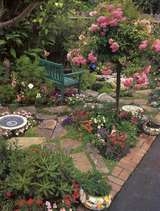Lately I’m getting a lot of requests for garden coaching. The economy probably has something to do with it. People want to know what plants will thrive in the different areas of their gardens or why something isn’t working. Who can afford to waste $ on the wrong plant in the wrong location? When I make house calls there are several problems that seem to keep cropping up. Maybe one of these tips will help make your garden grow.
Poor soil
If your soil looks like a sandy beach, amend it each time you plant something new with organic matter like compost or planing mix. Then be sure to mulch the surface to preserve precious moisture and soil structure and keep roots cool. Yearly, add organic mulch around existing planting keeping the immediate area around the crown of the plant open. If your native soil is just a little on the sandy side, you may not need to amend the soil much before planting but don’t forget that all important mulch. Crushed gravel or cobbles uses as a mulch holds in moisture the same way as bark or compost.
Those of you who live under redwoods may have the opposite problem- heavy clay soil, dense enough to make pottery. Surprisingly, adding organic matter to these soils solves this problem, too. The key is preserving the soil structure fterwards by mulching so it doesn’t pack down every time you water or during the winter rains.
Not watering deep enough or watering too often
Sure there’s a period of time when you first plant something that you need to water more often until it’s established but even then watering every day is rarely needed. As a rule of thumb, water a new 1 gallon plant when the top 1/2 " – 1" is dry. A newly planted 5 gallon container will need watering when the top 1 1/2 – 2" is dry. A tree or large shrub planted from a 15 gallon container needs watering when the top 2-3" is dry. Hot days as well as shady locations vs sunny sites will all affect how long you can go between waterings. When you do water apply enough to water the entire root zone deeply. If the water doesn’t penetrate 1-3 ft down, depending on the plant, it will suffer and even die. Drip systems are great if you have them set properly. Don’t waste water by having your timer set for 10 minutes every other day. If you have 1 gal/hour emitters that’s less than 3 cups of water each. How deep is that going to penetrate? Set your system so that each zone gets enough water for long enough to really count. This applies to established low-water use plants, too. They need a deep soak every 2-4 weeks.
One last tip on drip systems: make sure the emitter isn’t right next to the stem or trunk. Plants need water applied at the drip line where the feeder roots are located, not drowning the crown. Move it out as the plant grows and the dripline enlarges.
Gopher baskets
If you need to plant in gopher baskets, make sure you eliminate the air pockets between the root ball and the side of the basket. Many times I’ve dug around a plant that is not doing well only to find big air spaces down the side of the basket or the planting hole where the soil was not properly tamped down. The roots on that side of the plant will die under these conditions and possibly the whole plants will be killed.
Right plant-wrong place
Become familiar with the sun patterns of your property during the growing season- spring through fall. Many of us don’t have winter sun and lots of plants can adapt to this but they are more exacting when it come to light requirements during the growing season. It gets pretty hot around here so a spot with sun in the afternoon is fatal to a plant that is not a sun lover. For those optimists out there, those delicate rays that filter through your trees do not constitute a sunny garden. You have bright shade and there are lots of great plants that can provide color and texture in your shady garden. Make sure you follow tip #1 in both spots so your plant isn’t fighting crummy soil on top of everything else it has to handle.
Hopefully, these tips will help make your garden grow better.


.jpg)